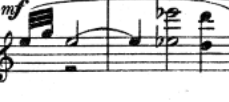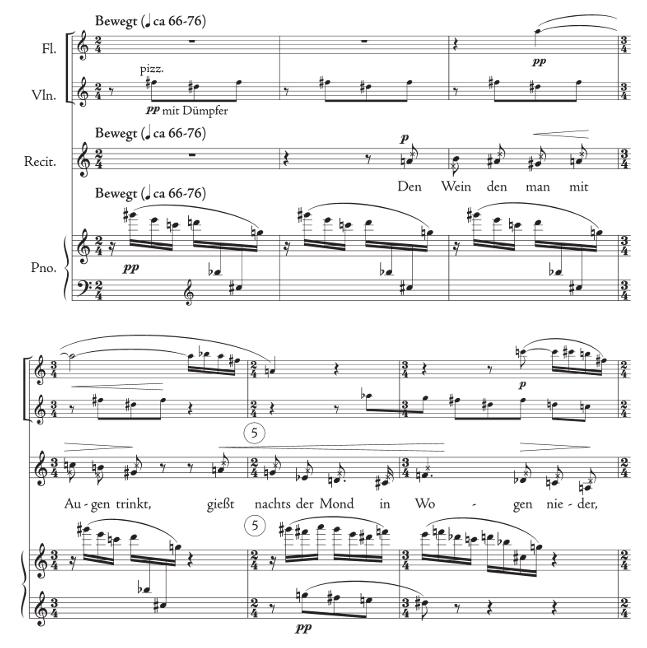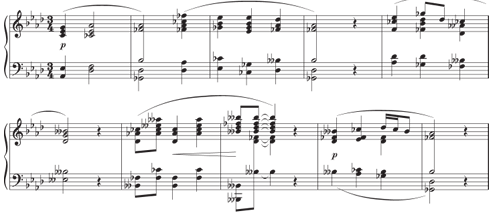Music of Modern Era Midterm
1/77
There's no tags or description
Looks like no tags are added yet.
Name | Mastery | Learn | Test | Matching | Spaced |
|---|
No study sessions yet.
78 Terms
1- Richard Wagner
1859- Prelude to Tristan and Isolde
2- Richard Wagner
1859- act III, scene 3 “Transfiguration” from Tristan and Isolde
Wagner gral info
First composer to write his own librettos- “poems” for his “dramas”
He hoped to revive and renew the ritual theater of ancient Greece
He considered people’s reliance on Christianity a weakness
Endless melody
A seamless stream in which every note is thematic and meaningful
Wagnerian Leitmotifs
Structure in compositions featured tiny musical themes repeated in everchanging combinations
Shorter than what is typically a full-fledge theme.
Tristan and Isolde general info
Wagner interested in Schopenhauer’s philosophy. The idea of “will”, in music the desire for resolution.
Music tension tries to portray the emotional, sexual and psychological tensions and fluctuations
Tristan chord: French +6 chord with a predominant function. F- B- Eb- G# passing to the A (B is the tritones from F)
Still tonal music, chromatic
Avoids cadential resolution
“Endless melodies”
Romanticist romantic yearing
Didn’t call them operas, called them music dramas instead.
Storyline of Tristan and Isolde
Love story: Tristan and Isolde are seized to forbidden love, they attempt to acto un it but are forcibly separated
Tristan is mortaly wounded, Isolde doesn’t die she “becomes one with the world.” dying in sympathy “transfigurating”
Just then does the piece resolve.
Gesamtkustwerk
The total work of art
1- Gustav Mahler
1888- First Symphony, mvt. III
Mahler’s First Symphony
“Funeral March”
Intro played by double bass uncomfortably high
Sense of something being streched, pushed into an uncomfortable place.
2- Gustav Mahler
1902- Gustav Mahler, Fifth Symphony, mvt IV (Adagietto)
Mahler’s Fifth Symphony general info
Part of Mahler’s middle period
Deathly atmosphere is fostered by the slow tempo in which the movement was performed
Suspension upon suspension
“Aching” towards resolution
Wanted to express the world in his pieces
Tereskin refers to Mahler as a maximalist
Mahler was nostalgic, torn between the past and the present/future.
Piece can be read as a love letter as well as a death letter
Maximalism
Radical intensification of means towards traditional expressive ends
Emotional expression
Metaphysical issues addressed
Sensuality
Larger orchestras
Longer, louder and more complicated textures in pieces
Increase the range of key relationship.
More dissonance and postponment of resolutions.
Mahler gral info
9 Symphonies
Jewish family
One of fourteen kids (8 of them passed)
Age of 16, Vienna conservatory
1897 offered to be director of the Vienna Court Opera
He combined Beethovenian symphonic tradition with Wagnerian dramatugy and philosophical import
Creating “Dramatic Symphonies”
Lied
Setting poetry to classical music (between 1880-90s Mahler focused on folk poetry)
Richard Strauss
1905- end of final scene, from “Warum…” from Salome
Strauss gral info
Interest in Nietzsche’s philosophy, specifically “Thus spake Zarathustra”
Salome specifically is based on Freud’s connection between desire and death.
Born in Munich.
Wrote two conventional symphonies than moved to program-music with a four movement symphonic fantasy
First tone poem “Macbeth”
Salome
Story taken from Oscar Wild’s play in French
Ilicit desires from Salome
Salome daughter of Herodias who is Herodes’ wife.
Salome was attracted to John the Baptist, the prisoner
King Herod desires Salome, she does the “Dance of the Seven Veils.”
After she dances she gets the prophet’s head on a platter and kisses it on the mouth.
Herod orderds Salome’s death
Desire is maximalized.
Laws of tonality are broken.
Opening suggests C#m and Gm which give place to the dissonant tritone
At the end the D major chord stands out resolving a half step lower, on Cm rather than on C#m (the key of the piece)
Salome Motive

1- Arnold Schoenberg
1899- Verklarte Nacht [Transfigured Night]
Schoenberg Gral Info
Music theorist, and composition teacher, self-taught
One of the most disruptive composers in the history of Western Music
Tried to expand Viennise heritage
Influenced by Dehmel (German leading poet and prominent decadent) he was erotic, sensual, resonant with Freud’s psychoanalyitc theories
Early period: tonal, highlu chromatic
Middle period: atonal
Late period: 12-tone period
Combines Wagner’s “roving harmony” and Brahm’s “developing variation”
Emancipation of dissonance
One of Schoenberg’s goals to be achieved in his pieces
Schoenberg’s theoretical writings: Hamonielehre (theory of harmony)
Schoenberg preferred to call atonal “pantonal” suggesting a single transcendent, all-ecompnassing tonality.
Expressionism
Cannot be fully understood apart from Freud’s psychoanalytic movement.
Explore human unconscious, in Freud’s case through scientific inquiry in Schoenberg’s case through art.
Portraying something that is hidden not only from others but from oneself as well.
Grundgestalt
“basic shape”
a motivic complex that could serve as a source for everything htat happened in a composition
Verklarte Nacht (Transfigured Night- Schoenberg)
tone poem, unusually, for string sextet rather than for orchestra
Poem is about two people walking, she expresses being pregnant and all the fears this entails and the conflict of also being in love with the man with shich she is walking with. He responds in an accepting way.
Uses a ninth chord and piece is rejected (Ab- C- Eb- Gb- Bb, in fourth inversion)
Atonal Miniatures
Trend to create short pieces where all tonal references were abandoned
Pierrot Lunaire
A atonal collection of twenty-one miniatures.
Part of Schoenberg’s middle phase, atonal - expressionist phase
Each poem had 13 lines, divided in 4+4+1+5, first and second lines come back as seventh and eighth
He transferred the Xs from the note heads to the stems so that the spoken technique could be transferred to hald notes and dotted halves.
It is not the performer’s responsability to recreate the mood based off the meaning of the words. but rather solely on the music.
Speaking voice in Pierrot Lunaire
Sprechstimme
Maintan accurate rhythm as if one was singing
Be aware of the difference between singing voice and speaking voice.
Speech song
Sprechgesand
2- Arnold Schoenberg
1912- I. “Mondenstrunken: [Moondrunk'], Pierrot Lunaire
Mondenstrunken
First tone poem in Pierrot Lunaire, sets the scene for all the hallucinatory verses to come.
There is an intentional structure to the notes, three notes in the violin against seven in the piano, 7×3=21

3- Arnold Schoenberg
1912- VIII “Nacht” [Night], Pierrot Lunaire
Nacht- Schoenberg
Text about night and the unsettling feeling of the darkness
Stops thinking about notes in relation to a key but starts thinking about the intervalic relationship between notes.
Relationship between notes of M and m 3rds
Three note motive that is set and repeated in various forms throughout the piece: grundgestalt.
Free notes, empancipating the dissonance
Form of passacaglia, comes from Spanish “pasar” to go by, gives the sense of movement an unstable walk

Erik Satie
1887- First Sarabande from Trois Sarabandes
Sarabande: barroque style dance suite

1- Claude Debussy
1894- Prelude to the Afternoon of a Faun
Choreography by Nijinsky
“2 dimensional stage” designed by Baskt
Nijinsky “flattened” the dance to a 2 dimensional plane.
2- Claude Debussy
1899- I. Nuages [Clouds], Nocturnes
Octatonic-scale (non-diatonic) is the pattern
Fifths used often, general sense of things moving down
No tonal direction
Specific focus on instrumentation (orchestral color) experimentation with timbre, how can a certain sound quality be achieved with different combinations of instruments.
3- Claude Debussy
1903- “Pagodes”, Estampes [Prints]
Pentatonic scale used
![<p>1903- “Pagodes”, Estampes [Prints]</p><ul><li><p>Pentatonic scale used</p></li></ul><p></p>](https://knowt-user-attachments.s3.amazonaws.com/647180d7-a838-4ecd-a72e-2475cb99b8bb.png)
4- Claude Debussy
1907- “Cloches a travers le feuilles” [Bells through the leaves”, Images,book II
Wholetone scale used
5- Claude Debussy
1909- “Violes”, Preludes, book I
Violes
Offeres intensified version of this new harmonic freedom
First section composed off of a whole-tone scales
Impressionism
Interested in how light and image impressed itself on our eyes, or any sensation on our sensory aparatus
What is sight all about? light
Stravinsky
Early period: Russian Period. Wanting to portray russian mythology and ritualS
Why does the tritone keep showing up?
It is exactly the middle of the octave
Empancipates dissonance.
Rite of Spring Gral info
Ballet premiered 29 May 1913 in Paris
Scandal in music history. Cause commotion in the audience because of its primitive representation.
Inspiration and initial idea: a virgin dancing herself to death before the ancient slavic sun god.
Created in tablaeaus: models representing a scene
Tableaus based around a Russian holiday pagan rituals
The ballet has two tableaus:
The adoration of the Earth
The Sacrifice
Each has an introductory section, a series of dances and concluding ritual.
Introduction played by the bassoon in an unusually high register, melancholic melody.
The bass, octatonic countermelody.
melody from the introduction adapted from folk tunes, specifially Lithuanian wedding songs. (combination of authenticicity and modernity)
Melody fragmented as well as several different ideas happening at the same time
Maximal dissonance to portray the inhumanity of the primitive religion.
Choreo by Nijinsky, Impresario Diaghilev.
1- Igor Stravinsky
1913- Introduction to Part I, The Rite of Spring
2- Igor Stravinsky
1913- “Dance of the Adolescentes”, The Rite of Spring
Regular meter (2/4)
Regular rhythm (eighth notes)
Irregular accents
“Unthinkingness”
3- Igor Stravinsky
1913- “Dance of the Earth (Part I finale), The Rite of Spring
Ending of Tableau 1
Montage of ostinatos
Two type of rhythmic innovations, static, unchanging ostinato or vamp
Rhythm of irregularly spaced downbeats, requiring changes in the notation of meter and bar lines, “variable downbeat”
No pattern for the entrance of chords
regular meter
not very regular rhythm
irregular accents
4- Igor Stravinsky
1913- “Sacrificial Dance of the Chosen One”, The Rite of Spring
two rhythmic / metric types
The static ostinato and the active shifting stress.
The Rite Chord
Eb7 (in first inversion) and a Fb chord, two tetrachords a tritone apart.
Vaughan Williams
1910- Fantasia on a Theme of Thomas Tallis
Thomas Tallis was a British composer
Uses Phrygian mode
Mysterious sound
Scored for string quartet and double string orchestra, to create and antiphonal sound (what we consider stereo today)
Bela Bartok
Born in Hungary, what today is Romania
Ethnomusicologist
Relates peasant’s music and the “remote language of atonality” attributing atonality to old Hungarian folk songs.
Considered folk music had the ability to transform music culture.
Collected recording form slovak peasants with a “horn” which is marked on a wax cilindir, he’d go back listen to it and transcribe it
1- Bela Bartok
1908- Bagatelle No.4 Fourteen Bagatelles, Op. 6
Harmonizes a folk song
2- Bela Bartok
1936- mvt I Andante tranquilo, Music for Strings, Percussion and Celesta
Instrumentation is divided into two groups on the stage
Theme and it’s inverse outlining tonic to tritone and back
Starts at A and goes up and down by 5ths ending up on Eb, tritone from the initial note.
At the end a single line quickly outlines this “tonic to tritone” journey.
3- Bela Bartok
1936- mvt. II, Allegro, Music for Strings, Percussion, and Celesta
In sonata form, exposition, 1st theme, 2nd theme and cadence theme
Verticle edgy sound.
4- Bela Bartok
1937- first of the Six Dance in Bulgarian Rhythm, no. 148 in Mikrokosmos, vol 6.
Charles Ives Gral Info
Born in Connecticut
Parents were musicians
14 y/o youngest person to get a organist license
Uses bitonality or politonality, having two key areas in the same piece
Experiments with quarter tones, politonality and polyrhythms
Ives was not trying to found a music style, instead he was trying to add a certain “communicativev dimension to his music through the essentially literary device of allusion”
1- Charles Ives
1914- II. “Putnam’s Camp, Redding, Conn.” Three places in New England
Scherzo like form
Second of Three Places in New England
Field that served as campground to troops under command of Israel Putnam.
Ives imagines a child getting lost in this campground at a military fair.
Juxtaposition and fragmentation of two groups of instruments against eachother playing at different tempos.
Overlapping and constant use of known tunes such as a phrase of “Yankee Doodle” or the bass instruments playing “The Star-Spangled Banner” at the end of the piece.
The Concord Sonata
Closely related to the European tradition, particularly German.
Celebrate nostalgia rather than progress.
The essence of New England Transcendentalism was symbolized by Ives’s use of the first four notes of Beethoven’s fifth symphony
2- Charles Ives
1920- “The Alcotts,” Piano Sonata No. 2, Concord, Mass 1840-60
After Bronson Alcott and Lousa May Alcott
Chordal hymn like sound
Composed with no bar lines
3- Charles Ives
1920- IV. “Thoreau,” Piano Sonata No., Concord Mass
After Henry David Thoreau
“The Human Faith Melody”: Ives imagined Thoreay playing on the flute in his boar in Walden Pond. The second line of which recalls the opening of Beethoven’s Symphony no.5
Ending is an atonal chord
5- Igor Stravinsky
1923- I. Sinfonia, Octet for Wind Instruments
Example of the Neoclassical style (rejection of atonality and of German compositions at the time)
Sonata form
For flute, clarinet, bassoons, trumpets and trombones.
Complete sonorous scale, rich register
Eliminates nuances, replaced by volume instead. Only dynamics are forte and piano
Piece should be executed, not interpreted
“New version of absolute music”
Polemic- poles, complete opposites leading to controversy. “Some Ideas on my Octuor”
Octour as a musical object for ensemble of musical instruments. It is sound.
Not an “emotive” work it is solely about the counterpoint of the piece.
6- Igor Stravinsky
1923- II. Tema on variazone. Octet for Wind Instruments
7- Igor Stravinsky
1923- III. Finale, Octet for Wind Instruments
4- Arnold Schoenberg
1923- I. Praludium, Suite for Piano, op. 25
No direction
No resolution
Notes in relation to one another rather their function within a key
Part of Schoenberg’s late- 12-tone period.
A tone row is not a melody but the organization of all twelve pitches of the chromatic scale.
“Prime row”
Inversions and retrogrades
5- Arnold Schoenberg
1923- II. Gavotte, Suite for Piano, op.25
Alban Berg
1926- mvt. I Allegretto giovale, Lyric Suite for string quartet
Berg never lets go of romanticism and combines it with 12 tone
mixes free atonality and strict twelve tone
Prime row 5 (first row) includes all possible intervals.
Lyricism, desire for order and the audience’s understanding and connection with the piece.

Anton Webern
1938- mvt. I, Massig, String Quartet
Structural rigor
Vertical piece
Spaced out notes
“atomistic”, fragmented piece
Webern was interested in franco-flemish composers, specifically Bach and would ‘hide’ note combinations in his pieces that spelled out Bach, Bb= B, A, C, B=H
Ragtime
anti-romantic sentiment past world war 1
American composers wanted to create distinctive american music
Jazz was used to refer to what formerly had been ragtime: highly syncopated African American music, popular in 1890s-1910s.
Combines the “for on the floor feel of sousa marches and cakewalk.”
Cakewalk is a dance done at southern plantations and minstrals (paradoy in which black and white people put coal on their facces)
The Blues
an African American folk that fed into jazz.
Generally a style of expressive performance as well as specifically to a musical form later standardized, 12 bar blues’
I—> Four bars, IV—> four bars, I for two bars and then V for two bars.
Used as a means for survival and addresses daily life experiences
Addresses affective labor as well: child rearing, taking care of the sick and educating as “women’s work”
“Race records” were sold, marketed to black consumers
lyric’s form a-a-b, repeat first line and closing line
rhyme form a-a-a, allows for musical and lyrical improvisation.
Blue notes
in a C major scale, Eb, F#, Gb, Bb
the sound of “bending” sound neither major or minor
sense of instability
Spirituals
combines elements of West-African music, call and response, messages of better life either in heaven, looking for togetherness and community.
Division of music when looking at historiagraphy
Classical vs. Popular
Cultivated vs Vernacular
Vernacular comes from “verna” in latin, meaning “family slave” common uneducated people.
Scott Joplin
1899- Maple Leaf Rag
Mamie Smith (voice), Perry Bradford (composer)
1920- “Crazy Blues”
People did not want this record solely for Mamie’s voice but for its meaning
Went addressing the frustration of an abusive lover, to desire of suicide to being tired with the system and wanting to confront this issue.
Expressing tiredness of feeling tired.
Not in a standardized 12 bar blues.
Musical community formation, people would gather at record stores to listen to these songs
G.W. Thomas (composer)
1927- Sippie Wallace, Louis Armstrong, “If You Ever Been Down.” Blues
The break: the inbetween section where the response takes place, has historical and racial implications as well
Wallace sings and Armstrong replies on his trumpet
Clarinet also is a part of the call and response in the second 12 bar
Armonstrong improvises the third twelve bar
Improvised polyphony
The call and response is important as an expression of acknowledgement “I hear you and I reply”
William Grant Still
1930- mvt. I, Moderato assai, Symphony No. 1 (“Afro-America”)
First theme shows blue notes, and is based off a 12 bar blues.
Grant was a black composer determined to put black music into the symphonic setting
George Gershwin
1924- Rhapsody in Blue
Gershwin tried to bridge popular music and classical music.
Clarinet bends (blue notes) the way in which the voice would bend.
Work has multiple themes
Contrasting romantic second theme
Duke Ellington
1943- “Come Sunday,” Black, Brown, and Beige
Wanted to present black music on stage
Wanted to perform this in Carnegie hall multiple times.
This piece addresses questiond of colorism.
Piece moves through work life, spiritual life and happy night life.
The song became a standard
Mahalia Jackson, famous gospel singer sang it.
Strong beat imitation off the sound of workers heaving whrn railroads ar put down, trying to portray the hard and taxing work done here.
Originally instrumental, then transformed into vocal piece
Idea of song being connected to church.
Ellington wanted their music to be taken seriously regardless of the audience’s color
Jazz enters symphonic culture.